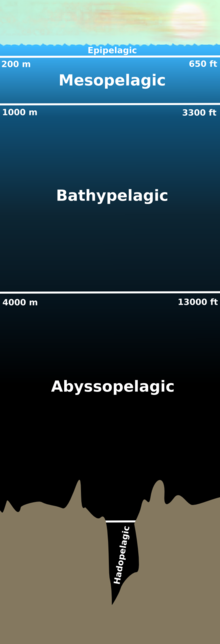Abyssal zone: Difference between revisions
m Reverted edits by 68.153.117.232 (talk) to last version by ClueBot |
jobs |
||
| Line 4: | Line 4: | ||
The area below the Abyssal Zone is the sparsely inhabited [[Hadal Zone]]. The zone above is the [[Bathyal Zone]]. These three zones belong to the deep-sea realm. Above on the continental platform there are respectively the '''Circalittoral, Infralittoral, Mediolittoral''' and '''Supralittoral''' Zones . The [[photic zone]] is independent from this classification. |
|||
'''fix it again and I will track you down''' |
|||
== See also== |
== See also== |
||
Revision as of 15:43, 15 May 2008

The abyssal zone is the pelagic zone that contains the very deep benthic communities near the bottom of oceans. Abyss is from the Greek word meaning bottomless sea. At depths of 4,000 to 6,000 meters (13,123 to 19,685 feet), this zone remains in perpetual darkness and never receives daylight. Its permanent inhabitants – for example, the Black swallower, tripod fish, deep-sea anglerfish, and the giant squid – are able to withstand the immense pressures of the ocean depths, up to 775 kilograms per square centimeter (76 megapascals or 4.92 long tons force per square inch). Many abyssal creatures have underslung jaws to sift through the sand to catch food. The deep trenches or fissures that plunge down thousands of feet below the ocean floor – for example, the midoceanic trenches such as the Mariana Trench in the Pacific – are almost unexplored. Only the bathyscaph Trieste and the remote control submarine Kaiko have been able to descend to these depths. These regions are also characterized by continuous cold and lack of nutrients. The abyssal zone has temperatures around 2 to 3 degrees Celsius, but 13-15°C in the Mediterranean Sea.
fix it again and I will track you down
